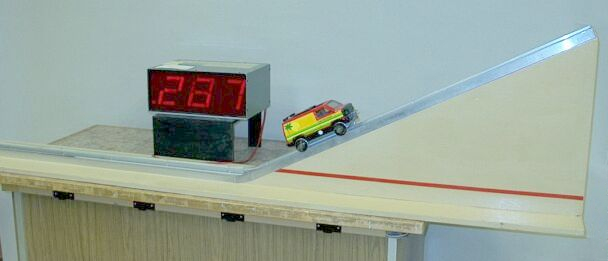
Otherwise known as “Baja bug,” this demonstration illustrates the conversion of kinetic energy into gravitational potential energy. Actually, it shows the conversion of the potential energy of an extended spring into kinetic energy, then into gravitational potential energy.
At left in the photograph above, the dark line in the center of the track is the spring. Pulling the toy van to the left extends the spring. The maximum extension is about 0.28 m. You pull the van back and then release it. The spring then accelerates the van toward the incline. After the van has come clear of the spring, its left front wheel opens a microswitch, starting the counter-timer shown in the photograph. 0.50 m after the first microswitch, the wheel opens a second microswitch, stopping the timer. 0.50 m divided by the time thus recorded gives the speed of the van on the flat.
The van proceeds up the incline and is decelerated by gravity until it comes to rest. That is, the van’s kinetic energy has been converted to gravitational potential energy. A ratchet mechanism prevents the van from rolling backwards once it comes to a stop. The white dot gives the location of the center of mass of the van. The red line shows the starting height of the van’s center of mass. The van’s speed, v, equals s/t = 0.5 m/t, and its potential energy at the end of its travel on the incline, neglecting friction, is mgh = (1/2)mv2. So the maximum height to which the van can travel up the incline is h = v2/2g. Friction in the ratchet mechanism lowers this height somewhat.
In case it might be useful for discussing how this sytem works, the maximum extension of the spring is 0.278 m, and the mass of the van is 1.31 kg (1,307 g). Equating the potential energy of the extended spring to the kinetic energy of the van at launching gives (1/2)kx2 = (1/2)mv2. Rearanging this gives k = mv2/x2 = (1.31 kg/(0.278 m)2)v2 = 17.0 v2, in units of N/m.